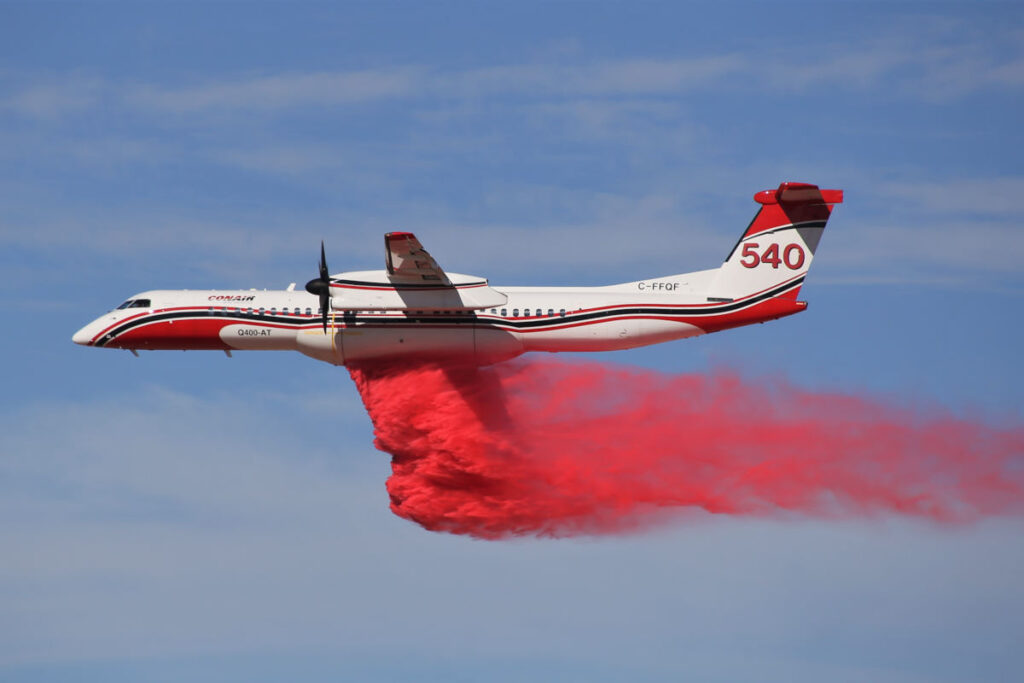
Features
Aerial Firefighting
Emergency Services
Newest Conair Dash 8-400AT fights wildfires in Alberta
June 5, 2023 By Wings Staff
 The Conair’s Dash 8-400AT, identifiable by its unique external tank, is designed to preserve the integrity of the airframe and to maintain a pressurized cabin to reduce pilot fatigue. (Photo: Steve Whitby, Conair)
The Conair’s Dash 8-400AT, identifiable by its unique external tank, is designed to preserve the integrity of the airframe and to maintain a pressurized cabin to reduce pilot fatigue. (Photo: Steve Whitby, Conair) Conair’s fleet of 70 firefighting aircraft have been deployed for the fire season, including a new Dash 8-400AT that, along with three other of these large airtankers, has been working record setting early wildfires in Alberta during the month of May.
The company’s mix fleet of 70 firefighting aircraft includes Bird Dog lead planes, amphibious waterbombers and airtankers. The Conair converted Dash 8-400AT, explains the Abbotsford based company, is the newest airtanker available in the world today. The Dash 8-400 airtanker has been operating since 2005. The multi role version of this aircraft is owned and operated by the Government of France, a fleet of eight built by Conair, with each aircraft offering a variety of emergency response roles including medevac, passenger, cargo, combi plus airtanker capability.
Conair, in operation for more than 50 years, has partnered with governments around the globe to now provide the largest fixed-wing, privately owned fleet of aerial firefighting aircraft in the world.
Conair adapted the Dash 8-400 into an airtanker-only version, the Dash 8-400AT, and introduced it to Australia in 2020, Alaska in 2021 and BC in 2022. The fleet has grown steadily over the last several years as new airtankers are certified by Transport Canada, explains Conair, which is the only regulating authority in the world recognizing aerial firefighting as its own air operation classification, with stringent guidelines in place to ensure airtankers operating in Canada do so safely.
This year BC welcomed three Dash 8-400ATs, with one positioned in Fort St. John and two based in Penticton, taking the place of the now retired Convair CV580 fleet.
“Retiring our legacy fleet of Electra L188 and Convair CV580 aircraft was necessary as the supply of parts was dwindling globally. We reached a point where we could not guarantee the serviceability needed for an emergency response aircraft so we proactively replaced our fleet with a modern airtanker,” said Jeff Berry, Vice President of Business Development with Conair. “The Dash is fully supported by De Havilland Canada, the Original Equipment Manufacturer, ensuring an abundant supply of parts is readily available to keep the airtanker flying for decades. This provides the level of reliability we require.”
Conair currently has two more Dash 8-400AT in production this year with plans for more to come online with growing demand.
Conair notes that Canada isn’t limited to just these three Dash 8-400 airtankers for wildfire response, because of interagency agreements, aerial firefighting airtankers on contract with Canadian jurisdictions and U.S. states can be shared if need arises. An example, utilizing the Northwest Wildland Fire Protection Agreement, Alaska has on loan to Alberta two of its contracted Dash 8-400AT airtankers.
If provinces or territories across Canada need additional airtanker support, Conair explains Transport Canada certified tankers are ready to assist through established compacts. Two Dash 8-400AT airtankers, for instance, are currently on contract through Washington state, ready to support Canada if conditions permit and the need arises.
Conair explains the Dash 8-400AT fits the bill for all regions across Canada by offering large airtanker payload capacity that is capable of dropping up to 10,000 litres of retardant, foam or water, while still being able to operate out of smaller airtanker bases with 5,000 foot runways at higher elevations, positioned closer to where wildfires occur.
“As an aerial firefighting pilot operating in mountainous terrain, I have greater confidence in the Dash over other airtankers I have flown. The sheer power and efficiency of the PW150A engines is a wonderful thing. It takes off fast and gets to the fire as fast as a jet,” said Captain Chris Bingham. “The tanker also burns far less fuel than other large airtankers. In some instances, the tanker can drop more than double the payload for fuel burned. This means we can continue more reloads and returns to the fire before requiring a refueling stop. That’s 10,000 litres per drop, drop after drop.”